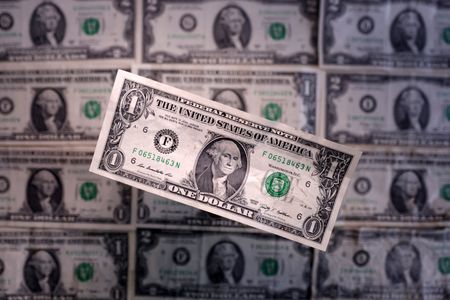By Jamie McGeever
ORLANDO, Florida (Reuters) – TRADING DAY
Making sense of the forces driving global markets
By Jamie McGeever, Markets Columnist
U.S. debt despair
Investors’ unease about holding long-dated sovereign debt was magnified by a soft 20-year U.S. Treasury note auction on Wednesday, which slammed the dollar and stocks, pushed long bond yields higher and steepened the U.S. yield curve.
In my column today I take a closer look at the rising term premium on U.S. debt. How much higher can it go? More on that below, but first, a roundup of the main market moves.
I’d love to hear from you, so please reach out to me with comments at jamie.mcgeever@thomsonreuters.com. You can also follow me at @ReutersJamie and @reutersjamie.bsky.social.
Trading Day is also sent by email every weekday morning. Think your friend or colleague should know about us? Forward this newsletter to them. They can also sign up here.
If you have more time to read, here are a few articles I recommend to help you make sense of what happened in markets today.
1. Weak U.S. economic outlook persists despite brief tradetruce with China 2. What’s in the Republican tax and spending plan? 3. Target cuts annual forecasts as tariff pressure mounts,demand slows further 4. Japan’s portfolio reshuffle raises red flag for U.S.:Mike Dolan 5. UK inflation jumps in April, raising prospect of BoErate cut delay
Today’s Key Market Moves
* Wall Street slides across the board, with the S&P 500losing 1.6%, the Nasdaq 1.4%, the Dow 1.9%, and the Russell 2000small-cap index shedding 2.6%. * Treasury yields surge as much as 13 bps at the long end ofthe curve – 10-year yield scales 4.60%; 20-year and 30-yearyields hit 4.13% and 5.10%, respectively, both the highest sinceOctober 2023. * Another down day for the dollar, as the dollar index falls0.5%, with the euro, Aussie dollar and yen the big winners. * The Japanese yen rallies for a seventh consecutive day, awinning streak last seen in March 2017. * Bitcoin rises to a record high just shy of $110,000,before easing back after the soft U.S. 20-year bond auction.
Bond alarms ring louder
After a poor 20-year government bond auction in Japan on Tuesday, it was the turn of a weak sale of 20-year U.S. debt on Wednesday to cast a cold, dark shadow over world markets and put investors on the defensive.
The trouble is, when supposedly safe-haven sovereign bonds are at the root of the deepening market angst, the selloff takes on a more worrisome significance. And when it’s U.S. Treasuries specifically, the cause for concern is even greater.
Wednesday’s auction of 20-year notes, the first sale of U.S. government debt since Moody’s stripped the U.S. of its triple-A rating last week, drew softer demand than usual, but what soured sentiment and risk appetite was the high yield investors demanded.
That was always going to be the case really – investors of all stripes from every corner of the world will buy Treasuries, the only doubt is the price. It was clearly lower than expected on Wednesday, and markets reacted accordingly.
Washington’s fiscal profligacy remains a major source of anxiety for bond investors. Non-partisan analysts say President Donald Trump’s tax-cut bill proposals will add between $2 trillion and $5 trillion to the $36 trillion federal debt over the next decade.
The 20-year Treasury note auction provided fuel for the bond fire, but fixed income was already smoldering on Wednesday – long-dated Japanese yields were at record highs and figures showed UK inflation rose much faster than expected to 3.5% in April, the highest in over a year.
Tariffs, monetary stimulus, rising debt levels, poor fiscal discipline, growing policy risk, sticky inflation and soaring inflation expectations – these are some of the reasons investors around the world are reluctant to go long ‘duration’, or buy long-dated bonds. It’s a potent mix, and all markets are feeling the heat.
U.S. markets, in particular, are under pressure as the rest of the world reevaluates its holdings of dollar-denominated assets in light of Trump’s global trade war and drive to upend the world economic order of the past 80 years.
Steep declines in U.S. stocks, Treasuries and the dollar on Wednesday point to a nervy global session on Thursday.
How much higher can the U.S. term premium go? A lot
Financial markets have had a fairly muted reaction to Moody’s decision to strip the United States of its triple-A credit rating last week, fueling hopes that the action will do little long-term damage to U.S. asset prices, as was the case when the U.S. suffered its first downgrade in 2011.
But given today’s challenging global macroeconomic environment and America’s deteriorating fiscal health, that may be wishful thinking. To monitor the impact in the coming months, a key indicator to watch will be the so-called ‘term premium’ on U.S. debt.
When Standard & Poor’s Global became the first of the three major ratings agencies to cut America’s top-notch rating in August 2011, there was little blowback because Treasuries were still widely considered the safest asset in the world. Demand for U.S. bonds went through the roof, despite S&P’s landmark move, and yields and the term premium plummeted.
That’s unlikely to happen now.
In 2011, the U.S. debt/GDP ratio was 94%, a record at the time reflecting a surge in government spending in response to the 2008-09 Global Financial Crisis. But the fed funds rate was only 0.25%, and inflation was 3% but falling. It dropped to zero a few years later and did not return to 3% until the pandemic in 2020.
It’s a vastly different picture today. U.S. public debt is around 100% of GDP and projected to rise to 134% over the next decade, according to Moody’s. Official interest rates are above 4%, inflation is 2.3% but expected to rise as tariff-fueled price hikes kick in. Meanwhile, consumers’ short- and long-term inflation expectations are the highest in decades.
And while the $29 trillion Treasury market is still the linchpin of the global financial system, increasing U.S. policy risk is prompting the rest of the world to rethink its exposure to U.S. assets, including Treasuries – ‘de-dollarization’ is underway.
HISTORICALLY LOW
Put all that together, and it’s easy to see why the ‘term premium’ – the risk premium investors demand for holding longer-term bonds rather than rolling over short-term debt – is liable to rise after this downgrade, unlike 2011. Especially given its relatively low starting point.
True, the term premium was already the highest in a decade before the Moody’s downgrade on Friday, and is now 0.75%, or 75 basis points. But that is still well below the level in 2011 and slim by historical standards.
In July 2011, the term premium on 10-year Treasuries was over 2.0%, but quickly slumped after the S&P downgrade the following month to below 1% and was negative within a few years. Treasuries were downgraded, but their status as the world’s undisputed safe-haven asset remained intact.
The last time Uncle Sam’s debt or inflation dynamics were as concerning as they are today, the term premium was much higher. It rose to 5% during the ‘stagflation’-hit 1970s, and was around 4% following the ‘Volcker shock’ recessions in the early 1980s triggered by the Fed’s double-digit interest rates to quell double-digit inflation.
“The term premium has come up quite a bit recently and is likely going to rise more given the fiscal challenges the U.S. is facing,” notes Emanuel Moench, professor at Frankfurt School of Finance & Management and co-creator of the New York Fed’s ‘ACM’ term premium model.
“The worry some investors might have is a self-fulfilling debt crisis – a high debt/GDP ratio increases interest rates, which raises the interest rate burden of the government and means you can’t so easily grow yourself out of this anymore. This may push the term premium higher.”
FEEL THE SQUEEZE
The question is, how high can it go?
History suggests it can go a lot higher until Washington exerts some serious fiscal discipline, or until the squeeze on households, businesses and the federal government from higher market-based borrowing costs gets too much.
Some analysts reckon another 50 basis points this year, which would take the 10-year yield up to around 5.00%, a pivotal level for many investors and the historical post-GFC high from October 2023.
With fiscal uncertainty so high and policy credibility so low, it’s a “tenuous” time right now for Treasuries, as Moench notes. The global environment is nervy too – Japan’s 30-year yield this week soared to a record high.
BlackRock Investment Institute strategists point out that long-term Treasuries still carry a “relatively low risk premium versus the past”, and their “starting point” in their portfolio construction is to assume a rising term premium and “persistent” inflation pressure. They are underweight long-dated Treasuries.
Treasuries will always attract buyers. It’s just that the clearing price they accept may be lower, and the term premium they demand may be higher. The risk now is it’s a lot higher.
What could move markets tomorrow?
* India, Japan, UK, Germany, euro zone, U.S. flash PMIs(May) * ECB’s De Guindos, Escriva speak in Madrid * BoE’s Sarah Breeden, Swati Dhingra, Huw Pill speak atvarious events * Richmond Fed President Thomas Barkin, New York FedPresident John Williams speak at separate events * U.S. weekly jobless claims * U.S. 10-year TIPS auction * G7 finance ministers and central bank chiefs meet inCanada
Opinions expressed are those of the author. They do not reflect the views of Reuters News, which, under the Trust Principles, is committed to integrity, independence, and freedom from bias.
(By Jamie McGeever; Editing by Nia Williams)










